Armorial of the First French Empire
Below is a list which presents and describes of the coat of arms of the Nobility of the First French Empire in France between 1804 and 1814, and 1815.
Note: all information is from each respective coat of arms' pages regarding their description, correct positions, etc.
Emperor of the French
| Birth (French) Name | Local Name | Noble Title | Subsidiary titles | Coat of Arms | Grand Arms | Portrait | Term begin | Date end | Description |
|---|---|---|---|---|---|---|---|---|---|
| Napoléon Bonaparte | Napoléon I | Emperor of the French, King of Italy (see below), Protector of the Confederation of the Rhine (12 July 1806 – 19 October 1813), and Mediator of the Swiss Confederation (19 February 1803 – 19 October 1813) | Co-Prince of Andorra (from 1806), Grand Duke of Berg and Cleves (from 1809) |  |
2.svg.png.webp) |
 |
18 May 1804 | 11 April 1814 | Azure, an Eagle Or, head facing to the sinister, clutching in its talons a Thunderbolt Or.[1][2] |
| King of Italy |  Arms of the Napoleonic Kingdom of Italy |
.2.svg.png.webp) |
 Napoleon I of France by Andrea Appiani |
17 March 1805 | 11 April 1814 | An escutcheon, with a silver pale charged with the blue Milanic serpent (spitting out the first human for the Duchy of Milan). Both sides of the pale are divided horizontally. The upper right field shows the papal parasol with the keys of Saint Peter. The upper left shows the Venetian lion, but without bible and with a Phrygian cap (revolutionary symbol) on its head (for the Papal States). The lower right quarter shows the white eagle of the house of Este (for the Duchy of Modena) and the lower left shows the arms of Piemonte, but under to the right charged with a silver tower (for Rovigo and Feltre (for the Republic of Venice)). The shield is charged with an escutcheon showing the Iron Crown of Lombardy (with pinnacles (for the Ligurian Republic) in a red border with silver rings. | |||
| King of Elba |  |
13 April 1814 | 26 February 1815[lower-alpha 1] | Argent, on a bend Gules three bees Or. | |||||
| Emperor of the French | Co-Prince of Andorra |  |
2.svg.png.webp) |
 |
20 March 1815 | 22 June 1815 | Azure, an Eagle Or, head facing to the sinister, clutching in its talons a Thunderbolt Or.[1][2] | ||
| Napoléon François Joseph Charles Bonaparte | Napoléon II |  |
2.svg.png.webp) |
 |
22 June 1815 | 7 July 1815 | Azure, an Eagle Or, head facing to the sinister, clutching in its talons a Thunderbolt Or.[1][2] | ||
Empresses
| Birth (French) Name | Local Name | Noble Title | Subsidiary titles | Coat of Arms | Grand Arms | Portrait | Term begin | Date end | Description |
|---|---|---|---|---|---|---|---|---|---|
| Joséphine | |||||||||
| Marie-Josèphe-Rose de Tascher de La Pagerie (Joséphine de Beauharnais) | Joséphine I | Empress of the French | Queen of Italy (26 May 1805 – 10 January 1810), Viscountess of Beauharnais |  |
 |
 |
18 May 1804 | 16 December 1806 | Azure, an Eagle Or, head facing to the sinister, clutching in its talons a Thunderbolt Or.[1][2] |
| Queen of Italy | Viscountess of Beauharnais |  Arms of the Napoleonic Kingdom of Italy |
.2.svg.png.webp) |
 Joséphine Reine d'Italie by Andrea Appiani |
17 March 1805 | 16 December 1809 | An escutcheon, with a silver pale charged with the blue Milanic serpent (spitting out the first human for the Duchy of Milan). Both sides of the pale are divided horizontally. The upper right field shows the papal parasol with the keys of Saint Peter. The upper left shows the Venetian lion, but without bible and with a Phrygian cap (revolutionary symbol) on its head (for the Papal States). The lower right quarter shows the white eagle of the house of Este (for the Duchy of Modena) and the lower left shows the arms of Piemonte, but under to the right charged with a silver tower (for Rovigo and Feltre (for the Republic of Venice)). The shield is charged with an escutcheon showing the Iron Crown of Lombardy (with pinnacles (for the Ligurian Republic) in a red border with silver rings. | ||
| Duchess of Navarre[lower-alpha 2] | Duchess of Navarre,
Viscountess of Beauharnais |
 |
 Coat of arms of Josephine de Beauharnais |
 Empress Joséphine of the French |
8 April 1810 | 29 May 1814† | Quarterly, first: Azure with an imperial eagle Or, encroaching a thunderbolt of the same, second and third: Argent a fess Sable surmounted by three martlets of the same (Armes des Beauharnais) and fourth : Or with three pals Vert. | ||
| Marie Louise | |||||||||
| Maria Ludovica Leopoldina Franziska Therese Josepha Lucia | Marie Louise I | Empress of the French |  |
 Blason de Marie-Louise d'Autriche, Impératrice des Français |
 Empress Marie Louise of the French |
1 April 1810 | 6 April 1814 | Attached from France and Austria, which started from two lines; 1st Or, a lion Gules armed, langued and crowned Azure; , second Gules a the fess Argent; third Or, a bend Gules, charged with three alerions Argent. With a mantle of gules, sown with golden bees, fringed with gold, lined with ermines, with an imperial crown surmounted by a globe surmounted by a crisscrossed cross. | |
| Queen of Italy |  Arms of the Napoleonic Kingdom of Italy |
.2.svg.png.webp) |
 Empress Marie Louise of the French |
1 April 1810 | 6 April 1814 | An escutcheon, with a silver pale charged with the blue Milanic serpent (spitting out the first human for the Duchy of Milan). Both sides of the pale are divided horizontally. The upper right field shows the papal parasol with the keys of Saint Peter. The upper left shows the Venetian lion, but without bible and with a Phrygian cap (revolutionary symbol) on its head (for the Papal States). The lower right quarter shows the white eagle of the house of Este (for the Duchy of Modena) and the lower left shows the arms of Piemonte, but under to the right charged with a silver tower (for Rovigo and Feltre (for the Republic of Venice)). The shield is charged with an escutcheon showing the Iron Crown of Lombardy (with pinnacles (for the Ligurian Republic) in a red border with silver rings. | |||
House of Bonaparte
| Birth (French) Name | Local Name | Noble Title | Relations | Coat of Arms | Grand Arms | Portrait | Term begin | Date end | Description |
|---|---|---|---|---|---|---|---|---|---|
| Joseph Bonaparte | |||||||||
| Joseph Bonaparte | Joseph Bonaparte | French Prince | Son of Maria Bonaparte and Brother of Napoléon Bonaparte |  Smaller coat of arms of a French Prince during the Napoleonic Wars. |
 Grand Coat of Arms of a French Prince |
 Joseph Bonaparte Portrait |
1st: 18 May 1804
2: 22 June 1815 |
1st: 11 April 1814
2: 7 July 1815 |
Azure with a golden eagle encroaching a thunderbolt of the same. |
| Imperial French Prince | Son of Maria Bonaparte and Brother of Napoléon Bonaparte |  Smaller coat of arms of a French Prince during the Napoleonic Wars. |
 Grand Coat of Arms of a French Prince |
 Joseph Bonaparte Portrait |
18 May 1804 | 20 March 1811 | Azure with a golden eagle encroaching a thunderbolt of the same. | ||
| Giuseppe I | King of Naples (Kingdom of Naples) | Son of Maria Bonaparte and Brother of Napoléon Bonaparte | Beginning of Reign Coat of Arms of Joseph I Bonaparte as King of Naples  Arms of Joseph Bonaparte as King of Naples |
Beginning of Reign_au_d%C3%A9but_du_r%C3%A8gne.svg.png.webp) Grandes armes de Joseph Bonaparte (Roi de Naples) au début du règne 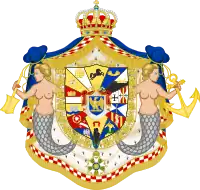 Coat of Arms of the Kingdom of Naples |
.jpg.webp) Joseph Bonaparte (by Wicar) |
30 March 1806 | 8 June 1808 | BEGINNING OF REIGN:
Cut: I, party: a, Azure, with two cornucopias Or passed in saltire (Terra di Lavoro); b, Azure, to a golden dolphin (alias a crowned fish tail) (Otranto); II, of gold, to a triquêtre issante of a head of Mercury of carnation (Island of Sicily); above all azure, with the golden eagle, the head turned, the flight lowered, encroaching a thunderbolt of the same. END OF REIGN: Gironné of 15 pieces: I, in the shape of a quarter-quarter, of gold, with a triquêtre issuant of a head of Mercury of carnation (Island of Sicily); II, of gold to the horse contouné and frightened of sand (of Naples (old)); 3, Azure, 2 horns of plenty Or, set in saltire (Terra di Lavoro); IV, cut in A Azure with a comet Argent hairy Or, in B Argent with a flight Azure; V, Or, to the eagle Gules, crowned with the field, issuant of a fess tilted and lowered Azure (of Basilicata); VI, Argent, to the cross potencée Sable (of Lower Calabria); VII, quartered in saltire Or, with four pals Gules and Argent, with the cross potencée Sable (alias of Aragon and Lower Calabria) (of Upper Calabria); VIII, Or, four pals Gules, a dolphin Argent, plunging towards the end, debruising above all (d'Otranto); IX, quartered in saltire Azure and Argent, with the butt of gold, debruised above all (of Bari); IX, Azure, to a Saint-Michel Or, slaying a devil Sable, on a mountain with three cups of the second, issante of the point (of Capitanate); XI, Gules, to a star with eight spokes of gold, surrounded by a crown of foliage of the same (of Molise); XII, cut Gules, with the antique crown of gold, and of silver. (from Upper-Crown); XIII, Or, to the head Sable, surmounted by a yoke Gules (of Lower Abruzzo); XIV, Azure, to the eagle Argent, surmounting a mountain Or, issante of the point (of the Upper Abruzzo); XV, Gules accompanied by two cross bored the whole Argent; above all azure, with the golden eagle, the head turned, the flight lowered, encroaching a thunderbolt of the same (of Napoleon) in his pavilion of gules. | |
| José I | King of Spain and the Indies (Kingdom of Spain) | Son of Maria Bonaparte and Brother of Napoléon Bonaparte |  Blason Joseph Ier Bonaparte Roi d'Espagne2 |
 Grand Coat of Arms of Joseph Bonaparte as King of Spain |
 Joseph-Bonaparte |
8 June 1808 | 11 December 1813 | Two contiguous shields: part of one and cut of two: in 1, Gules with the open castle of gold and openwork Azure (Crown of Castile), in 2, Argent with the lion Gules armed, langued and crowned with gold (Kingdom of León), in 3 Or with four pals Gules (Principality of Catalonia), in 4 Gules with gold chains set in orle, cross and saltire, charged in the heart of a natural emerald (Kingdom of Navarre), in 5 Argent with a pomegranate Gules, stalked and foliated Vert and (Kingdom of Granada) 6 Azure, and Gules in the old and new world Or between the columns of Hercules Argent; on the whole of Azure, with the golden eagle, the rounded head, with the lowered flight, encroaching a thunderbolt of the same (House of Bonaparte). | |
| Marie Julie Clary | Giulia I | Queen of Naples (Kingdom of Naples) | Wife of Joseph Bonaparte |  Blason Julie Clary2 |
 Grand Coat of Arms of Julie Clary Queen Consort of Naples |
 Julie Clary |
30 March 1806 | 8 June 1808 | Attached to the King of Naples and Clary: Coupé: I, party: a, Azure, with two cornucopias Or passed in saltire (Plowing); b, Azure, to a dolphin circled Argent (alias a crowned fish tail) (Otranto); II, of gold, to a triquêtre issante of a head of Mercury of carnation (Island of Sicily); above all azure, with the golden eagle, the head circled, the flight lowered, encroaching a thunderbolt of the same (from Napoleon to the golden eagle, the head circled, the flight lowered, encroaching a thunderbolt) of the same and that of Clary, Or with an eagle displayed Sable, membered, beaked and tied Gules, a chief Azure charged with a sun Or. |
| Julia I | Queen of Spain (Kingdom of Spain) | Wife of Joseph Bonaparte |  Blason Julie Clary |
 Coat of Arms of Julie Clary as Queen Consort of Spain |
 Julie Clary - enfants |
8 June 1808 | 11 December 1813 | Two contiguous shields: part of one and cut of two: in 1, Gules with the open castle of gold and openwork Azure (Crown of Castile), in 2, Argent with the lion Gules armed, langued and crowned with gold (Kingdom of León), in 3 Or with four pals Gules (Principality of Catalonia), in 4 Gules with gold chains set in orle, cross and saltire, charged in the heart of a natural emerald (Kingdom of Navarre), in 5 Argent with a pomegranate Gules, stalked and foliated Vert and (Kingdom of Granada) 6 Azure, and Gules in the old and new world Or between the columns of Hercules Argent; on the whole of Azure, with the golden eagle, the rounded head, with the lowered flight, encroaching a thunderbolt of the same (House of Bonaparte) and that of Clary, Or with the eagle displayed Sable, membered, beaked and bound Gules, a chief Azure charged with a sun Or. | |
| Lucien Bonaparte | |||||||||
| Lucien Bonaparte | Prince of Canino | Brother of Napoléon Bonaparte |  Blason Lucien Bonaparte |
 Coat of Arms of Lucien Bonaparte, Roman Prince of Canino |
 Fabre - Lucien Bonaparte |
18 August 1814 | 29 June 1840 | Elliptical shield, Gules with two bars of gold accompanied by two stars of the same, one in chief, the other in point crown of Roman Prince in the antique style, mantle Gules lined with ermine, Legion of honor. | |
| French Prince | 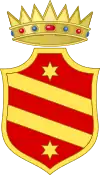 Stemma luciano bonaparte |
 Coat of Arms of Lucien Bonaparte during the Hundred Days2 |
.jpg.webp) Robert Lefèvre - Lucien Bonaparte, Prince de Canino (1755-1840) |
2 June 1815 | 1815 | On June 2, 1815, peer of France, making Lucien ipso facto a count of the Empire and French prince. (Nevertheless, he remains excluded from the imperial succession because of marriage not authorized by the emperor). | |||
| Louis Bonaparte | |||||||||
| Louis Bonaparte | Louis Napoléon Bonaparte | French Prince | Brother of Napoléon Bonaparte |  Smaller coat of arms of a French Prince during the Napoleonic Wars. |
 Grand Coat of Arms of a French Prince |
 Louis Napoléon peint par François Gérard |
18 May 1804 | 1 July 1810 | Azure with a golden eagle encroaching a thunderbolt of the same. |
| Lodewijk I | King of Holland (Kingdom of Holland) |  Blason du Royaume de Hollande |
.svg.png.webp) Coat of Arms of the Kingdom of Holland (1808) |
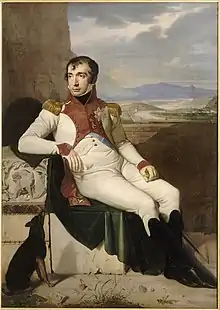 Louis Bonaparte by Vogel von Vogelstein |
5 June 1806 | 1 July 1810 |
Quarterly: I and IV, Gules, to the lion Or crowned with the same, holding in its dexter paw a bundle of seven arrows Argent, pointed and fletched Or, and in its sinister paw, a sword Argent, garnished with gold (Prince of Orange); II and III, Azure, with the golden eagle, the head rounded, with the lowered flight, encroaching a thunderbolt of the same (of Napoleon). | ||
| Napoléon-Louis Bonaparte | Napoléon-Louis Bonaparte | French Prince |  Smaller coat of arms of a French Prince during the Napoleonic Wars. |
 Grand Coat of Arms of a French Prince |
.jpg.webp) Cottrau - Napoléon-Louis Bonaparte (1804-1831) |
11 October 1804 | 1815 | Azure with a golden eagle encroaching a thunderbolt of the same. | |
| Louis I | Grand Duke of Clèves and Berg (Grand Duchy of Berg) | Son of Louis Bonaparte |  Coat of arms of Napoleon Bonaparte Louis Grand Duke of Cleves and Berg |
3 March 1809 | 1 December 1813 | Berg (Duchy of Berg) impaled with Clèves (Duchy of Cleves), overall an inescutcheon of Napoleon. | |||
| Napoléon-Louis Bonaparte | Prince Royal of Holland | 
 |
.jpg.webp) Cottrau - Napoléon-Louis Bonaparte (1804-1831) |
5 May 1807 | 1 July 1810 |
Quarterly: I and IV, Gules, to the lion Or crowned with the same, holding in its dexter paw a bundle of seven arrows Argent, pointed and fletched Or, and in its sinister paw, a sword Argent, garnished with gold (Prince of Orange); II and III, Azure, with the golden eagle, the head rounded, with the lowered flight, encroaching a thunderbolt of the same (of Napoleon). | |||
| Lodewijk II | King of Holland (Kingdom of Holland) |  Blason du Royaume de Hollande |
.svg.png.webp) Coat of Arms of the Kingdom of Holland (1808) |
1 July 1810 | 13 July 1810 |
Quarterly: I and IV, Gules, to the lion Or crowned with the same, holding in its dexter paw a bundle of seven arrows Argent, pointed and fletched Or, and in its sinister paw, a sword Argent, garnished with gold (Prince of Orange); II and III, Azure, with the golden eagle, the head rounded, with the lowered flight, encroaching a thunderbolt of the same (of Napoleon). | |||
| Louis-Napoléon Bonaparte | Louis-Napoléon Bonaparte | French Prince | Son of Louis Bonaparte |  Smaller coat of arms of a French Prince during the Napoleonic Wars. |
 Grand Coat of Arms of a French Prince |
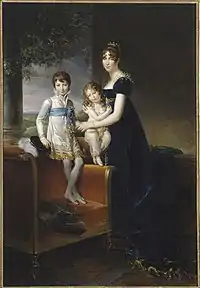 Hortense with her children |
20 April 1808 | 1815 | Azure with a golden eagle encroaching a thunderbolt of the same. |
| Prince Royal of Holland | 
|
20 April 1808 | 13 July 1810 |
Quarterly: I and IV, Gules, to the lion Or crowned with the same, holding in its dexter paw a bundle of seven arrows Argent, pointed and fletched Or, and in its sinister paw, a sword Argent, garnished with gold (Prince of Orange); II and III, Azure, with the golden eagle, the head rounded, with the lowered flight, encroaching a thunderbolt of the same (of Napoleon). | |||||
| Jérôme Bonaparte | |||||||||
| Jérôme-Napoléon Bonaparte | Jérôme-Napoléon Bonaparte | French Prince | Brother of Napoléon Bonaparte |  Smaller coat of arms of a French Prince during the Napoleonic Wars. |
 Grand Coat of Arms of a French Prince |
 Rümelin 40 Jérôme Napoléon |
18 May 1804 | 1815 | Azure with a golden eagle encroaching a thunderbolt of the same. |
| Jerome Napoleon I | King of Westphalia (Kingdom of Westphalia) | 2.svg.png.webp) Blason Jérôme Bonaparte (1784-1860)2 |
_2.svg.png.webp) Grandes Armes Jérôme Bonaparte (1784-1860) 2 |
 King Jerome Bonaparte |
9 July 1807 | 26 October 1813 | First quarter shows the silver horse of Westphalia (Electorate of Hanover); the second the lion of Hesse over the counties of Dietz, Nidda, Ziegenhain and Katzenelnbogen (Electorate of Hesse); the third was newly designed for non-specified territories around Magdeburg (Duchy of Magdeburg); and the fourth combined Brunswick, Diepholz, Lüneburg and Lauterburg (Principality of Brunswick-Wolfenbüttel). Around the shield are the Order of the Crown of Westphalia and the French Grand Aigle of the Légion d'honneur. Above is Napoleon's star. | ||
| Katharina Friederike von Württemberg | Katharina I | Queen Consort of Westphalia (Kingdom of Westphalia/Kingdom of Württemberg) | Wife of Jérôme Bonaparte |  Coat of Arms of Catherine of Württemberg following her marriage to Jérôme-Napoléon Bonaparte. Before her marriage, the left part (that of the King of Westphalia) wasn't part of her coat of arms. |
 Grandes Armes Catherine de Wurtemberg2 |
 Catharina of Württemberg - Queen of Westphalia |
22 August 1807 | 26 October 1813 | First quarter shows the silver horse of Westphalia (Electorate of Hanover); the second the lion of Hesse over the counties of Dietz, Nidda, Ziegenhain and Katzenelnbogen (Electorate of Hesse); the third was newly designed for non-specified territories around Magdeburg (Duchy of Magdeburg); and the fourth combined Brunswick, Diepholz, Lüneburg and Lauterburg (Principality of Brunswick-Wolfenbüttel). Around the shield are the Order of the Crown of Westphalia and the French Grand Aigle of the Légion d'honneur. Above is Napoleon's star.
For Kingdom of Württemberg coat of arms: First part of gold, with three half antlers of sable deer, which is for the Duchy of Württemberg, and Second Part of gold with three lions passing sable, for the Duchy of Swabia. |
Grand Dignitaries
Initially under the Constitution of the Year XII (1804), six Dignitaries of the Empire (Grandes Dignités de l'Empire) were created:
- Archchancellor of the Empire
- Archchancellor of State of the Empire
- Arch-Treasurer of the Empire
- Grand Elector of the Empire
- Constable of the Empire
- Grand Admiral of the Empire
The following grand dignitaries were later added:
- Vice Grand Elector of the Empire (1807)
- Vice Constable of the Empire (1807)
- Governor General of the Alps Departments (1809)
- Grand Duchess of Tuscany (1809)
- Governor General of the Dutch Departments (1810)
| Birth (French) Name | Noble Title | Coat of Arms | Grand Arms | Portrait | Term begin | Date end | Description |
|---|---|---|---|---|---|---|---|
| Jean-Jacques-Régis de Cambacérès | Archchancellor of the Empire | .svg.png.webp) Armoiries Cambacérès |
 Blason de la famille de Cambacérès |
.jpg.webp) Jean-Jacques-Regis de Cambaceres (par Henri-Frederic Schopin) |
1st: 18 May 1804
2nd: 20 March 1815 |
1st: 14 April 1814
2nd: 22 June 1815 |
Or, a dextrochère of carnation, adorned Gules, turned up Ermine, holding the tables of the law Sable, the whole accompanied by three lozenges Sable; , a chief Azure sown with bees Or, which is that of the Princes Grand Dignitaries. |
| Eugène de Beauharnais | Archchancellor of State of the Empire | .svg.png.webp) |
 Gérard - Eugène de Beauharnais 1 |
18 May 1804 | 1 February 1805 | Azure with a golden eagle encroaching a thunderbolt of the same, the thunderbolt charged with an oval silver medallion overloaded with an E of sand. | |
| Charles-François Lebrun | Arch-Treasurer of the Empire | _(Restauration).svg.png.webp) Blason Charles-François Lebrun (Duc de Plaisance) (Restauration) |
 Blason Charles-François Lebrun (1739-1824) (Empire) |
 Charles François Lebrun prince architrésorier de l'Empire |
18 May 1804 | 11 April 1814 | Sable, to a wolf stopped Or, supported of the same, surmounted by two billets Argent; , a chief cousu Azure sown with stars Or. |
| Joseph Bonaparte | Grand Elector of the Empire |  Smaller coat of arms of a French Prince during the Napoleonic Wars. |
 Grand Coat of Arms of a French Prince |
 Joseph Bonaparte Portrait |
18 May 1804 | 30 March 1806 | Azure with a golden eagle encroaching a thunderbolt of the same. |
| Louis Napoléon Bonaparte | Constable of the Empire |  Smaller coat of arms of a French Prince during the Napoleonic Wars. |
 Grand Coat of Arms of a French Prince |
 Louis Napoléon peint par François Gérard |
18 May 1804 | 5 June 1806 | Azure with a golden eagle encroaching a thunderbolt of the same. |
| Joachim Murat | Grand Admiral of the Empire | .svg.png.webp) Blason de Joachim Murat (1805) |
.jpg.webp) Murat (Gerard) |
18 May 1804 | 8 June 1808 | Shield on which is placed a double anchor, surrounded by the collar of the Legion of Honor placed on two Marshal's staff (azure sown with golden eagle), feathered helm, imperial mantle, marquis crown. | |
| Charles-Maurice de Talleyrand-Périgord | Vice Grand Elector of the Empire | _(Empire)2.svg.png.webp) Blason Charles-Maurice de Talleyrand-Périgord (1754-1838) (Empire)2 |
%252C_en_habit_de_grand_chambellan_-_P1065_-_Mus%C3%A9e_Carnvalet_-_01.jpg.webp) Prud'hon - Portrait de Charles-Maurice de Talleyrand-Périgord (1754-1838), en habit de grand chambellan - P1065 - Musée Carnvalet - 01 |
14 August 1807 | 11 April 1814 | Party: to the I Gules with three lion cubs Or armed, languid and crowned Azure (Talleyrand-Périgord); in the II of gold with the boar wild boar passing sand loaded on the back of a silver cover (Benevento); to the head of the Sovereign Princes of the Empire debruising the score. Re que Diou: RE QUE DIOU. | |
| Louis-Alexandre Berthier | Vice Constable of the Empire |  Coat of Arms of Louis-Alexandre Berthier |
 Louis-Alexandre Berthier |
1807 | 11 April 1814 | Party: to the I, Or, to the dextrochère Argent, armed with Azure heightened Or, holding a sword Sable and charged with a shield Sable to a W surrounded by Commilitoni Victor Caesar, the whole of or, to the head of the Princes Grand Dignitaries of the Empire (Wagram); 2nd, Or, pale Gules, charged with three chevrons Argent (Neufchâtel), a chief of Princes Souverains. | |
| Camillo Filippo Ludovico Borghese | Governor General of the Alps Departments |  Blason Camille Borghèse2 |
 Camille Borghèse |
24 February 1808 | 11 April 1814 | Party: to the I, Azure, to a winged dragon Or (Borghesi), a chief of the same, charged with an eagle Sable, beaked, membered and crowned Or (Holy Empire); to II, Gules with a parasol with gules and gold braid, topped with a gold cruciferous globe, the spear-shaped stem loaded with two long-salted keys with the bits facing outwards and towards the top, one of gold and the other of silver, bound in gules (gonfalonnier of the Church); to the head of sovereign prince debruising. | |
| Élisa Bonaparte | Grand Duchess of Tuscany |  Blason Elisa Bonaparte (1777-1820) |
 Blason Elisa Bonaparte (1777-1820) orn |
 Guillaume Guillon-Lethière - Elisa Bonaparte |
3 March 1809 | 1 February 1814 | Quarterly: I, Or with six spheres set in orle, five Gules, that in chief Azure charged with three fleur-de-lys Or (from Medici, for Tuscany); II, cut Argent and Gules (from Lucca); III, cut Gules and Or, the chief of the first charged with a two-headed eagle Sable, a crestier Sable with leaves of silver (alias of a branch of thorns Vert in pale) debruising, charged in abyss of 'an escutcheon Gules a bend checkered Argent and Azure, a chief Argent a cross Gules (of Cybo-Malaspina, for Massa and Carrara); IV, Gules with two bands Or accompanied of two mullets of the same; on the whole Azure, with the golden eagle, the circumvented head, with the lowered flight, encroaching a thunderbolt of the same (from Napoleon). |
Marshals of the Empire
| Birth (French) Name | Noble Title(s) | Noble Title Years[lower-alpha 3] | Coat of Arms | Grand Arms | Coat of Arms Description | Portrait | Raised to Marshal Date | Notes |
|---|---|---|---|---|---|---|---|---|
| Louis-Alexandre Berthier | I: Sovereign Prince of Neuchâtel and Valangin
II: Prince of Wagram |
I: 25 February 1806 – 3 June 1814
II: 9 July 1809 |
 Coat of Arms (cropped) of Louis Alexandre Berthier |
Party: to the I, Or, to the dextrochère Argent, armed with Azure heightened Or, holding a sword Sable and charged with a shield Sable to a W surrounded by Commilitoni Victor Caesar, the whole of or, to the head of the fr: Princes Grand Dignitaries of the Empire (Wagram); 2nd, Or, pale Gules, charged with three chevrons Argent (Neuchâtel), a chief of Princes Souverains. | .jpg.webp) Louis-Alexandre Berthier, Prince de Neufchâtel et de Wagram, maréchal de France (1753-1815) |
19 May 1804 | 1st in seniority for the 1804 First promotion of Marshals. | |
| Joachim Murat | I: Grand Duke of Berg and Clèves
II: Lieutenant General of the Realm of the Kingdom of Spain III: King of Naples |
I: 15 March 1806 – 1 August 1808
II: 4 May – 20 July 1808 III: 1 August 1808 – 19 May 1815 |
Coat of Arms as the Grand Duke of Berg & Clèves Blason Joachim Murat Grand-Duc de Clèves et de Berg  Arms of Joaquim Murat as king of Naples |
Coat of Arms as a Marshal and Admiral of the Empire (till 1806):.svg.png.webp) Blason de Joachim Murat (1805) .svg.png.webp) Blason Joachim Murat Grand-Duc de Clèves et de Berg (Orn ext) .svg.png.webp) Coat of Arms of the Kingdom of Naples (1808) |
As Marshal & Admiral of the Empire:
Shield on which is placed a double anchor, surrounded by the collar of the Legion of Honor placed on two Marshal's staff (azure sown with golden eagle), feathered helm, imperial mantle, marquis crown. As Grand Duke of Berg & Clèves: Party: in I of silver with a lion Gules, the forked tail passed in saltire (Duchy of Berg); in II Gules, to the escutcheon Argent, to the spokes of carbuncle Or, brochantes on the whole (Duchy of Cleves); on the whole azure with the golden eagle, the circumvented head, with the lowered flight, encroaching a thunderbolt of the same (from Napoleon), on the insignia of Grand-Admiral of the Empire. As King of Naples: Gironné of 15 pieces: I, in the shape of a quarter-quarter, of gold, with a triquêtre issuant of a head of Mercury of carnation (Island of Sicily); II, of gold to the horse contouné and frightened of sand (of Naples (old)); 3, Azure, 2 horns of plenty Or, set in saltire (Terra di Lavoro); IV, cut in A Azure with a comet Argent hairy Or, in B Argent with a flight Azure; V, Or, to the eagle Gules, crowned with the field, issuant of a fess tilted and lowered Azure (of Basilicata); VI, Argent, to the cross potencée Sable (of Lower Calabria); VII, quartered in saltire Or, with four pals Gules and Argent, with the cross potencée Sable (alias of Aragon and Lower Calabria) (of Upper Calabria); VIII, Or, four pals Gules, a dolphin Argent, plunging towards the end, debruising above all (d'Otranto); IX, quartered in saltire Azure and Argent, with the butt of gold, debruised above all (of Bari); IX, Azure, to a Saint-Michel Or, slaying a devil Sable, on a mountain with three cups of the second, issante of the point (of Capitanate); XI, Gules, to a star with eight spokes of gold, surrounded by a crown of foliage of the same (of Molise); XII, cut Gules, with the antique crown of gold, and of silver. (from Upper-Crown); XIII, Or, to the head Sable, surmounted by a yoke Gules (of Lower Abruzzo); XIV, Azure, to the eagle Argent, surmounting a mountain Or, issante of the point (of the Upper Abruzzo); XV, Gules accompanied by two cross bored the whole Argent; above all azure, with the golden eagle, the head turned, the flight lowered, encroaching a thunderbolt of the same (of Napoleon) in his pavilion of gules. |
.jpg.webp) Murat (Gerard) |
19 May 1804 | 2nd in seniority for the 1804 First promotion of Marshals. |
| Bon-Adrien Jeannot de Moncey | Duke of Conegliano | July 1808 | _duc_de_Conegliano.svg.png.webp) Blason Adrien Jannot de Moncey (1754-1842) |
Azure, a hand Or, winged and maintaining a sword in pale argent. |  Marechal Moncey |
19 May 1804 | 3rd in seniority for the 1804 First promotion of Marshals. | |
| Jean-Baptiste Jourdan | _(Restauration).svg.png.webp) Blason Jean Baptiste Jourdan (1762-1833) (Restauration) |
Azure, with the letters JBJ entwined Or; with a silver border, besantée Sable. |  Le maréchal Jourdan |
19 May 1804 | 4th in seniority for the 1804 First promotion of Marshals. | |||
| André Masséna | I: Prince of Essling
II: Duke of Rivoli |
I: 31 January 1810
II: 24 August 1808 |
_duc_de_Rivoli.svg.png.webp) Blason André Masséna (1758-1817) |
As Prince of Essling: As Duke of Rivoli: |
Under the head of the Princes of the Empire: of gold, to a Winged Victory of canarnation, dressed in silver, holding in his dexter hand a palm and in the sinister an olive wreath, the whole of vert, accompanied in tip of a dog lying on the sand. | .jpg.webp) André Masséna (Fontaine et Gros) |
19 May 1804 | 5th in seniority for the 1804 First promotion of Marshals. |
| Charles Pierre François Augereau | Duke of Castiglione | 19 March 1808 | _duc_de_Castiglione.svg.png.webp) Blason Charles Pierre François Augereau (1757-1816) duc de Castiglione.svg |
Azure with a lion Or, quarter of the Barons drawn from the army debruising to the ninth of the shield, and for liveries: blue, red, yellow. |  Robert Lefevre 20 |
19 May 1804 | 6th in seniority for the 1804 First promotion of Marshals. | |
| Jean Bernadotte | I: Prince of Pontecorvo | I: 5 June 1806 – 21 August 1810
II: 21 August 1810 – 5 February 1818 (became King of Sweden & Norway) |
As Crown Prince of Sweden:_Johan.svg.png.webp) Prins Karl (XIV) Johan |
As Prince of Pontecorvo: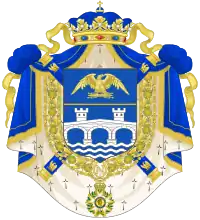 Coat of arms of Jean-Baptiste Bernadotte  Karl XIV Johan Prince de Suède |
As Prince of Pontecorvo:
Azure, a bridge with three arches Argent, on a river of the same, shaded Azure, and supporting two towers of the second; to the head of the Sovereign Princes of Empire debruising. |
.jpg.webp) Jean-Baptiste-Jules Bernadotte, Prince de Ponte-Corvo, roi de Suède, Maréchal de France (1763-1844) |
19 May 1804 | 7th in seniority for the 1804 First promotion of Marshals.
Accepted position of "Crown Prince of Sweden" on 21 August 1810 and dropped all French titles including marshalcy. |
| Jean-de-Dieu Soult | Duke of Dalmatia | 28 June 1808 | _duc_de_Dalmatie.svg.png.webp) Blason Nicolas Jean-de-Dieu Soult (1769-1851) |
Under the head of the Dukes of the Empire: gold, with the escutcheon Gules, charged with three heads of leopards of the first. | .jpg.webp) Jean-de-Dieu Soult, maréchal duc de Dalmatie (1769-1851) |
19 May 1804 | 8th in seniority for the 1804 First promotion of Marshals. | |
| Guillaume Marie-Anne Brune | Comte de Brune | 2 June 1815 | .jpg.webp) Guillaume Marie-Anne, comte de Brune, maréchal de France (1763-1815) |
19 May 1804 | 9th in seniority for the 1804 First promotion of Marshals. | |||
| Jean Lannes | Duke of Montebello | 1 June 1808 | _duc_de_Montebello.svg.png.webp) Blason Jean Lannes (1769-1809) |
Under the head of the Dukes of the Empire: Green, with the high sword Or. | _-_Le_mar%C3%A9chal_Lannes_(1769-1809)%252C_1834.jpg.webp) Julie Volpelière (d'après Gérard) - Le maréchal Lannes (1769-1809), 1834 |
19 May 1804 | 10th in seniority for the 1804 First promotion of Marshals. | |
| Adolphe Édouard Casimir Joseph Mortier | Duke of Trévise | 2 July 1808 | _duc_de_Trevise.svg.png.webp) Blason Adolphe Édouard Casimir Joseph Mortier (1768-1835) |
Under the head of the Dukes of the Empire: quartered, I and IV, gold, with the head of a sand horse, that of the I bypassed; II, Azure, to the right hand armed Or, holding a high sword Argent; III, Azure, to the senestrochere armed Or, holding a high sword Argent. |  Dubufe - Marshal Mortier |
19 May 1804 | 11th in seniority for the 1804 First promotion of Marshals. | |
| Michel Ney | I: Prince of the Moscow | I: 25 March 1813
II: 6 June 1808 |
_duc_d'Elchingen.svg.png.webp) Blason Michel Ney (1769-1815) |
Under the head of the Dukes of the Empire: Or, with a border Azure, an escutcheon Azure, charged with an orle Or, accosted with two back-to-back hands, dressed in sable, holding silver badelaires. |  Marechal Ney |
19 May 1804 | 12th in seniority for the 1804 First promotion of Marshals. | |
| Louis-Nicolas Davout | I: Prince of Eckmühl | I: 15 August 1809
II: 2 July 1808 |
_duc_d'Auerstaedt.svg.png.webp) Blason Louis Nicolas d'Avout (1770-1823) |
Under the head of the Dukes of the Empire: Or, 2 lions leopard gules, each holding a Polish lance Sable, one in the first canton, the other, bypassed, in the fourth canton. |  Louis nicolas davout |
19 May 1804 | 13th in seniority for the 1804 First promotion of Marshals. | |
| Jean-Baptiste Bessières | Duke of Istria | 28 March 1809 | _duc_d'Istrie.svg.png.webp) Blason Jean Baptiste Bessières (1768-1813) |
Under the head of the Dukes of the Empire: quarterly, to the I, Azure, to the lion Or; to II, Argent, to the hawk spinning Sable; 3rd, Or, a tower Azure, open Sable; 4th, Gules, to the fox passing Or. | .jpg.webp) Reisener - Portrait du maréchal Jean-Baptiste Bessières, duc d'Istries (1768-1813) |
19 May 1804 | 14th in seniority for the 1804 First promotion of Marshals. | |
| François-Étienne-Christophe de Kellermann | Duke of Valmy | May 1808 | _duc_de_Valmy.svg.png.webp) Blason François Christophe Kellermann (1735-1820) |
Under the head of the Dukes of the Empire: cut Gules with an inverted crescent Argent; and Argent, 3 mountains Vert, each surmounted of a star Gules. |  Marechal-Kellermann |
19 May 1804 | 15th in seniority for the 1804 First promotion of Marshals. Promoted as an "Honorary Marshal". | |
| François Joseph Lefebvre | Duke of Danzig | 10 September 1808 | _duc_de_Dantzig.svg.png.webp) Blason François Joseph Lefebvre (1755-1820) |
Party: 1st, Azure, to a right hand, cuirassed Argent, holding a sword of the same, garnished Or; 2nd, Or, a fess Vert, charged with two passers-by, each leading a woman, all Argent, the fess accompanied in chief by a flight Sable, and in base of a cross pattée reamed of the same; to the chief of the dukes of the Empire debruising. |  François-Joseph Lefebvre |
19 May 1804 | 16th in seniority for the 1804 First promotion of Marshals. Promoted as an "Honorary Marshal". | |
| Catherine-Dominique de Pérignon | Comte de Pérignon | 1808 | .svg.png.webp) Blason Catherine-Dominique de Pérignon (1754-1818) |
Azure, to a passing ram Argent, accorné Or, the head summoned of a patriarchal cross of the same; in the canton of the Counts Senators debruising. |  Dominique-Catherine Pérignon |
19 May 1804 | 17th in seniority for the 1804 First promotion of Marshals. Promoted as an "Honorary Marshal". | |
| Jean-Mathieu-Philibert Sérurier | Comte de Sérurier | 8 May 1808 | .svg.png.webp) Blason Jean Mathieu Philibert Sérurier (1742-1819) |
Gules, to the seated greyhound Argent; in the canton of the Counts Senators debruising. |  Jean mathieu philibert serurier |
19 May 1804 | 18th in seniority for the 1804 First promotion of Marshals. Promoted as an "Honorary Marshal". | |
| Claude Victor-Perrin | Duke of Belluno | 10 September 1808 | _duc_de_Bellune.svg.png.webp) Blason Claude-Victor Perrin (1764-1841) |
Under the head of the Dukes of the Empire: party, to the I of azure to the dextrochère argent garnished with moving gold of the partition: in II Or with a lion sable, a fess gules debruised. |  Claude-Victor Perrin |
12 July 1807 | Made a Marshal of the Empire in 1807 following his exemplary conduct at the Battle of Friedland. | |
| Étienne Jacques-Joseph-Alexandre Macdonald | Duke of Taranto | 9 December 1809 | _duc_de_Tarente.svg.png.webp) Blason Étienne Jacques Joseph Macdonald (1765-1840) Duc de Tarente |
Quarterly: 1st, Argent, to the lion Gules; 2nd, Or, a dextrochère, armed Gules, holding a cross crisscross at the stuck foot of the same; 3rd, Or, to a galley Sable, flagged and weather-vane Gules; 4th, Green; to the silver salmon; all below the head of the Duke of the Empire debruised. | 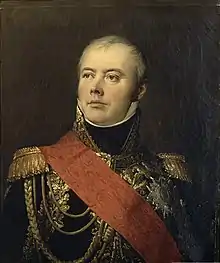 MacDonald par Antoine Jean Gros |
12 July 1809 | Made a Marshal of the Empire in 1809 following his conduct at the Battle of Wagram, and only Marshal ever appointed on a battlefield. Napoléon decreed he was the choice "for France". | |
| Nicolas Charles Oudinot | I: Duke of Reggio
II: Comte de Oudinot |
I: 14 April 1810
II: 19 March / 2 July 1808 |
_duc_de_Reggio.svg.png.webp) Blason Nicolas Charles Marie Oudinot (1767-1847) Duc de Reggio |
Party: I, Gules, 3 helmets Argent; II, Argent, to the lion Gules, holding a grenade Sable inflamed Gules; all below the head of the Duke of the Empire debruised. |  Nicolas Charles Oudinot by Robert Lefèvre |
12 July 1809 | Made a Marshal of the Empire in 1809 following his conduct at the Battle of Wagram. Napoléon decreed he was the choice "for the Army". | |
| Auguste Frédéric Louis Viesse de Marmont | Duke of Ragusa | 28 June 1808 | _duc_de_Raguse.svg.png.webp) Blason Auguste Frédéric Louis Viesse de Marmont (1774-1852) |
Quarterly: I and IV, Argent, 3 bends Gules; II, Or, to the standard Gules, to the cross Argent, set in bend, the trable Sable; III, party: a, Azure, to the Cross of Lorraine Or; Gules, to a flaming sword in pale Argent; all below the head of the Duke of the Empire debruised. |  Marmont |
12 July 1809 | Made a Marshal of the Empire in 1809 following his conduct at the Battle of Wagram. Napoléon decreed he was the choice "for Friendship". | |
| Louis-Gabriel Suchet | I: Duke of Albufera
II: Comte de Suchet |
I: 11 January 1813
II: 19 March / 24 June 1808 |
_duc_d'Albufera.svg.png.webp) Blason Famille Suchet Albufera |
Under the head of the Dukes of the Empire, party 3, cut into:
|
.jpg.webp) Gault - Le maréchal Suchet, duc d'Albufera (1770-1826) |
8 July 1811 | Made a Marshal of the Empire for his exemplary and conduct throughout the Peninsular War, and only marshal to gain his baton during said campaign. Awarded following the Siege of Tarragona. | |
| Laurent de Gouvion Saint-Cyr | Comte de Gouvion-Saint-Cyr | May 1808 | .svg.png.webp) Blason Laurent Gouvion-Saint-Cyr (1764-1830) |
Cut, at I, left of the district of the Military Counts of the Empire surrounded by a chain of silver and azure with a gold star; at II, sand | 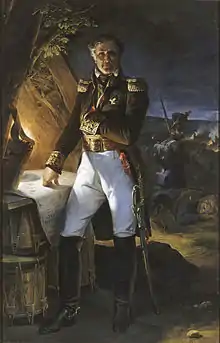 Laurent de Gouvion-Saint-Cyr |
27 August 1812 | Made a Marshal of the Empire for his brilliant defence and later tactical withdrawal which held off a Russian counter-attack at Polotsk twice. Granted his baton after the first battle. | |
| Prince Józef Antoni Poniatowski | No titles for the French Empire. |  Ciolek |
 Józef ks Poniatowski CoA |
Argent, with an ox Gules, on a green terrace. |  Prince Jozef Poniatowski, by Josef Grassi |
17 October 1813 | Only foreigner to become a Marshal of France under Napoleon, awarded for his bravery during the Invasion of Russia. | |
| Emmanuel de Grouchy | Comte de Grouchy | 28 January 1809 | .svg.png.webp) Blason Emmanuel de Grouchy (1766-1847) |
Or, fretté Azure; over-all Argent, 3 trefoils Vert; in the canton of the Military Counts of the Empire debruising |  Emmanuel de Grouchy 2 |
17 April 1815 | Initially a brave cavalry commander, but later blamed for Napoléon's defeat during the Hundred Days. Made a Marshal of the Empire on the advice of Marshal Louis-Nicolas Davout (Minister of War at this time). Last Marshal created by Napoléon. | |
Noble Titles of the Empire
Commune Amorial
During the Napoleonic Wars, several regions were integrated into 'Metropolitan France', becoming départements. These are listed separately.
Footnotes
Notes
- Napoleon left Elba on 26 February, however the title wasn't disestablished until 9 June.
- Though Napoléon and Joséphine had divorced in 1806, Napoléon kept her as an official "member of the senior family". Therefore, her title of Duchess of Navarre is kept here under Empress.
- The date is when the title was "confirmed by decree". If another year follows after that, this is when that title was abolished, or the titular holder dropped it, etc.
References
- L'Almanach impérial pour l'année 1810
- M. L. Sandret, Revue Historique, BiblioBazaar, 2008 (ISBN 978-0-559-53658-8)
- Albert Révérend, Armorial du Premier Empire : titres, majorats et armoiries concédés par Napoléon Ier, Picard, 1894
- J.-F. Jules Pautet Du Parois, Paris, à la librairie encyclopédique de Roret, 1854, 340 p. (lire en ligne [archive]) ;
- Jacques Jourquin, Dictionnaires des Maréchaux de Napoléon, Christian, 1999
- Jacques Jourquin, Dictionnaire des maréchaux du Premier Empire, 1986
- Thierry Lentz, Dictionnaires des Ministres de Napoléon, Christian, 1999
- Quintin, Dictionnaire des Colonels de Napoléon, SPM, 1996
- Raoul de Warren, Les Pairs de France au XIXe siècle, les Cahiers nobles, 1959 (Réed. en 1999 par l'Intermédiaire des chercheurs et des curieux) ;
- Philippe Lamarque, Armorial du Premier Empire, Édition du Gui, 2008, ISBN 978-2-9517417-7-5 ;
- Armorial des Chevaliers de l'Ordre de la Réunion - par M. Alcide Georgel (1869) Archived 2009-01-23 at the Wayback Machine ;
- Armorial de l'Empire français (L'Institut. - L'Université. - Les écoles publiques) - par M. Alcide Georgel (1870) Archived 2008-12-05 at the Wayback Machine ;
- Armorial de l'Empire français (Médecins et chirurgiens) - par M. Alcide Georgel (1869) Archived 2009-04-29 at the Wayback Machine ;
.svg.png.webp)

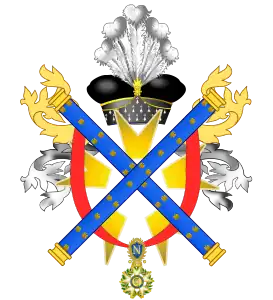

_prince_d'Essling.png.webp)
